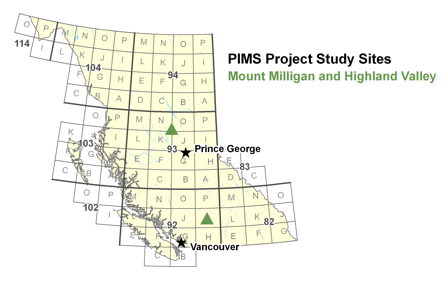Summary
 Quesnel and Stikine terranes in central British Columbia host Late Triassic to Early Jurassic arcs that are highly-prospective hosts for porphyry copper deposits. However, exploration success in this area is limited due to thin, but extensive veneers of till and related glacial sediments that cover much of the area. QUEST and QUEST-West are examples of projects that have provided a significant amount of new geochemical and geophysical data that warrant follow-up exploration efforts. We suggest that glacial materials may best host evidence of concealed deposits.
Quesnel and Stikine terranes in central British Columbia host Late Triassic to Early Jurassic arcs that are highly-prospective hosts for porphyry copper deposits. However, exploration success in this area is limited due to thin, but extensive veneers of till and related glacial sediments that cover much of the area. QUEST and QUEST-West are examples of projects that have provided a significant amount of new geochemical and geophysical data that warrant follow-up exploration efforts. We suggest that glacial materials may best host evidence of concealed deposits. Porphyry indicator minerals (PIMS) are minerals, such as apatite, rutile, garnet and titanite, that form during porphyry copper deposit formation and are resistant to weathering. Although easy to collect in heavy mineral concentrates, these minerals have rarely been used as exploration tools, but the QUEST area is an ideal region to test their applicability.
These minerals, when formed or altered in hydrothermal porphyry environments, commonly display unique physical properties such as color, size and shape that allow their presence to be used as a prospecting tool in a similar manner to which kimberlite indicator minerals are used. Moreover, the chemical compositions of PIMS can identify mineralizing environments that relate directly to specific alteration zones in porphyry systems. Therefore, by evaluating the presence, abundances, relative proportions, and compositions of PIMS from surficial materials, it is possible to evaluate and better rank geophysical and geochemical anomalies to vector towards concealed porphyry copper deposits.
The common occurrence of resistate minerals, such as apatite, rutile, titanite and titanomagnetite, as alteration products in BC porphyry copper deposits suggest that these minerals could be utilized as porphyry indicator minerals (PIMS) and potentially provide a new exploration tool for BC explorers. The research project evaluated several resistate minerals but focused mainly on apatite and Fe-oxide phases from the Highland Valley, Mt. Polley, Mount Milligan, Huckleberry, Lorraine and Endako porphyry deposits. This research project has successfully recognized, characterized and documented the occurrence, types, relative abundances and compositions of selected resistate minerals in several BC porphyry deposits, such that the "proof of concept" of PIMS has been established. In short, we can now recognize features of resistate minerals that indicate their association with mineralized porphyry systems. This tool will be particularly beneficial in improving exploration targeting in terrains covered by glacial till.
Apatite occurs as grains 50 to 200 μm long in both fresh and altered host-rocks. Under visible light, the binocular microscope and the SEM, there are no notable differences between apatite in fresh and altered rocks, however significant differences in their characteristics are easily observable under cathodoluminescence. Apatite in fresh rocks associated with porphyry deposits displays yellow, yellow-brown and brown luminescence. Apatite associated with K-silicate altered host-rock in all studies deposits displays characteristic green luminescence. The green-luminescent apatite replaces yellow or brown luminescent apatite and less commonly overgrows it. Apatite associated with muscovite alteration displays characteristic grey luminescence.
The chemistry of the apatites reflect their alteration and luminescence. The yellow luminescent apatite reflects its high concentrations of Mn, while the brown-luminescent apatite has low Mn, but higher concentrations of Cl, S and probably REE. The green luminescence is caused by lower Mn/Fe ratio. Other trace elements such as Cl, S, and Na were also depleted during K-silicate alteration. Grey luminescent apatite with muscovite alteration is the result of significant Mn and trace element loss during low pH phyllic alteration. Such apatites are not expected widely in alkalic deposits because such fluids were not developed in alkalic porphyry deposits.Magnetite occurs as a common accessory mineral in the host-rocks of BC porphyry deposits and displays uniform pink color when examined under reflected light (e.g. titanomagnetite). Magnetite in fresh rocks hosting porphyry deposits has a characteristic rim of hematite or titanite which is interpreted as evidence of an increasing oxidation state of the late crystallizing melts which led to the generation of the porphyry deposit. Magnetite grains associated with altered host-rocks in all studied porphyry deposits display remnant of pink magnetite replaced by hematite indicating that the oxidation state of the porphyry systems progressively increased to stabilize hematite during the transition from K-silicate to sericite or chlorite alteration. The Ti from titanomagnetite commonly forms rutile lamella or grains within or near magnetite-hematite bodies. More advanced stages of magnetite alteration forms spongy hematite, with rutile, cemented by hydrothermal quartz thus forming more resistate aggregates.
These textural observations and chemical characteristics indicate that the footprints of porphyry-related alteration on apatite and Fe-oxide phases can provide a unique and reliable tool to search for porphyry deposits. The correlation between apatite luminescence and magnetite replacement textures with the degree and intensity of porphyry alteration offers a fast and effective method to utilize these minerals as indicators for porphyry mineralization in the weathered environment.
Geoscience BC co-hosted an online webinar with MDRU – Mineral Deposit Research Unit on October 21, 2020 to discuss a series of research projects that show the potential to identify buried porphyry deposits from till or bedrock samples near the surface in British Columbia.